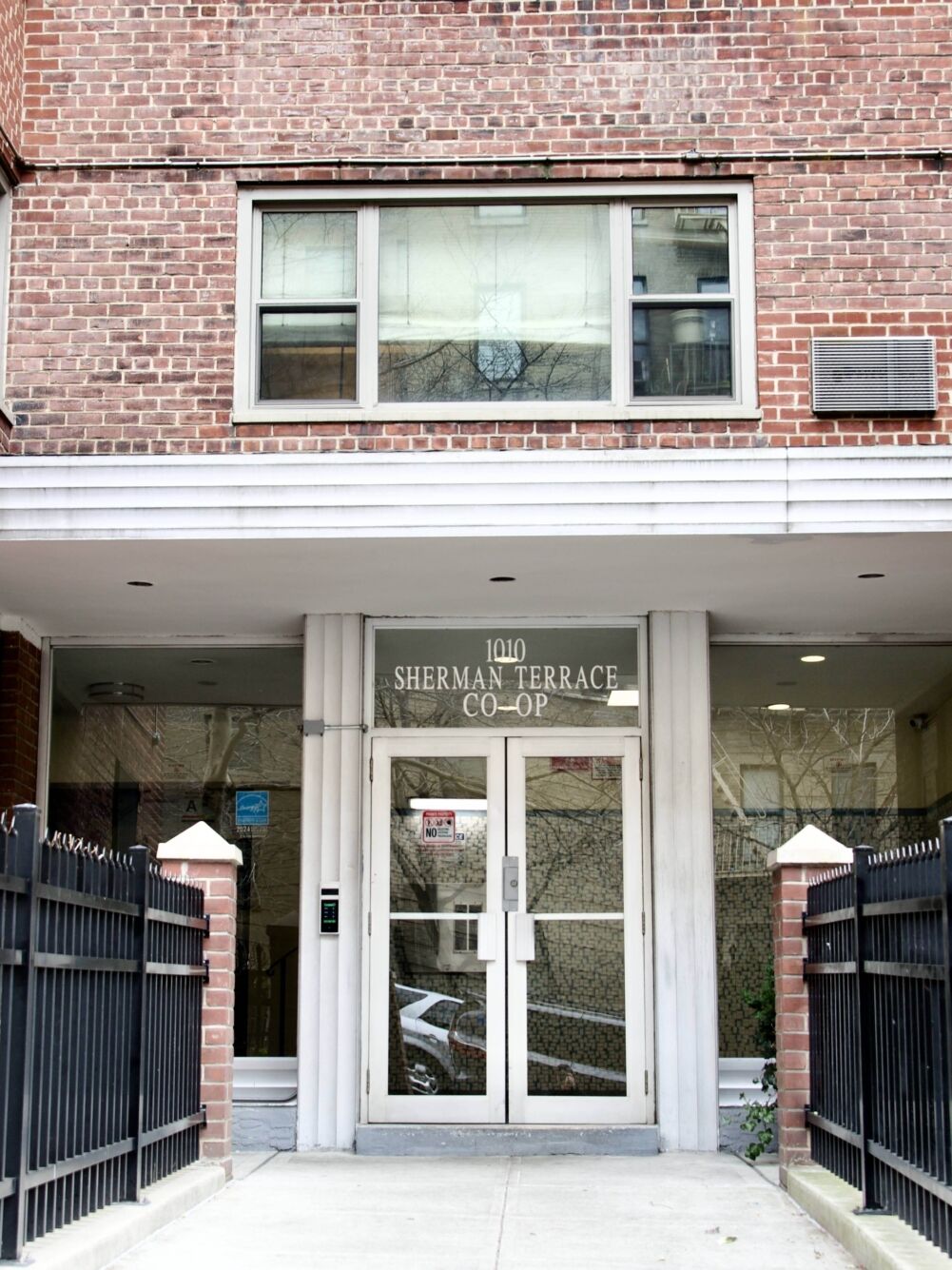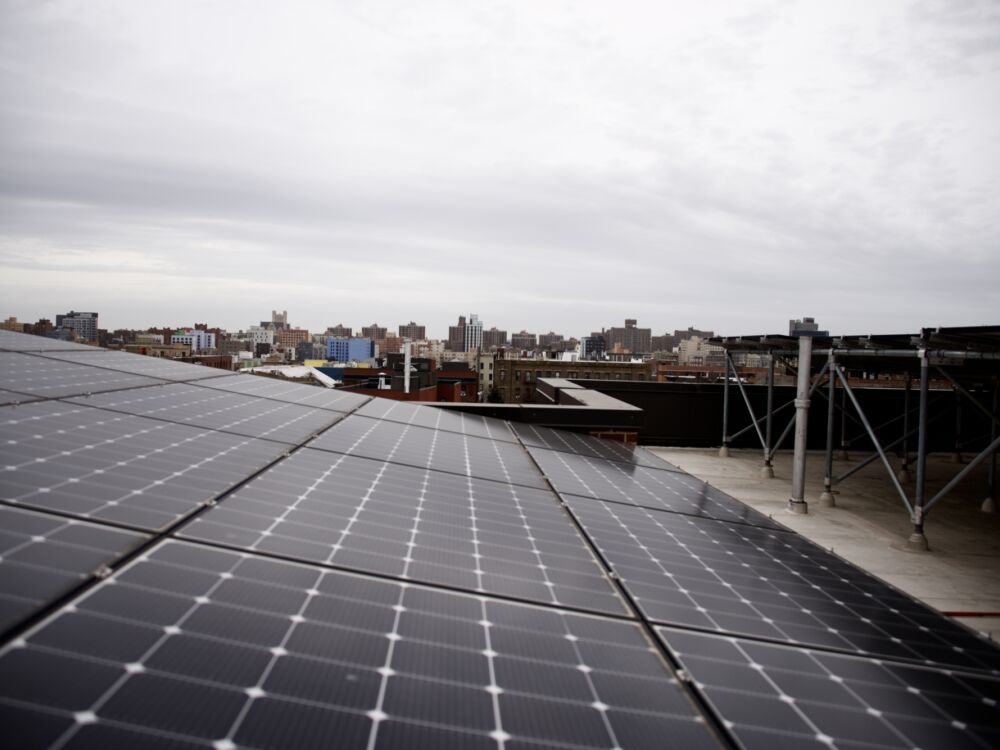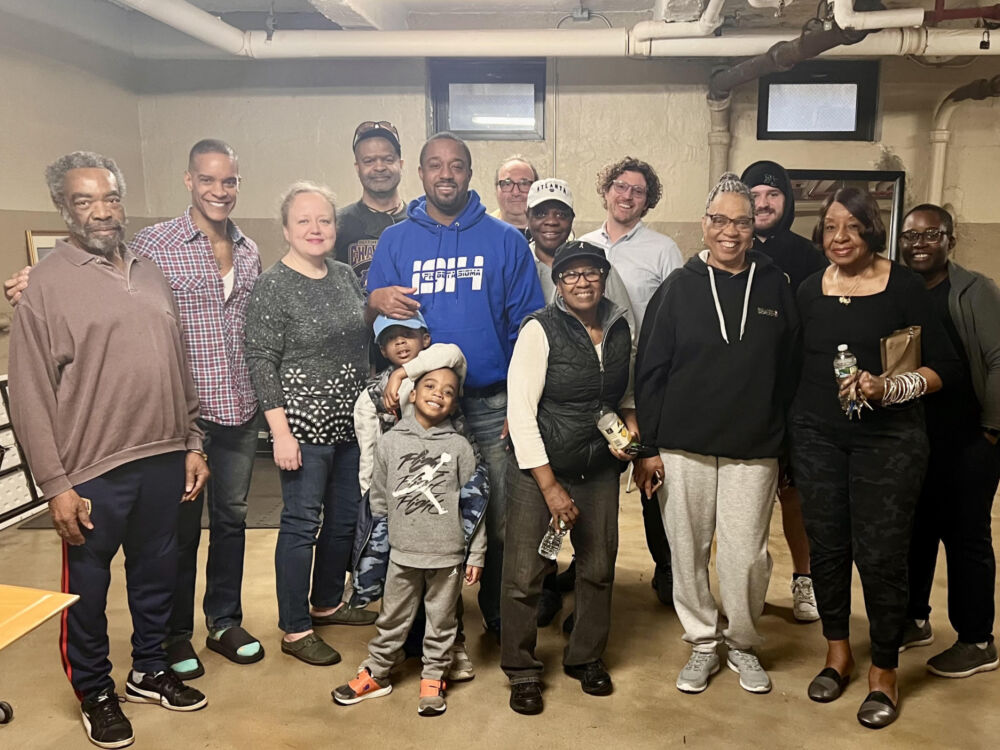
The entryway to Sherman Terrace Co-op in the Bronx. Photo: Demi Guo
How one working-class cooperative took an incremental approach to improving efficiency, and found savings along the way
When Derek K. Jones moved into the Sherman Terrace Cooperative at 1010 Sherman Ave. in the Bronx in 2018, he was pleased to see the building, originally built in 1958, already undergoing energy upgrades: New windows to prevent unnecessary A/C leaks, and an all-electric elevator to replace the older one that often broke. But after a year of riding the new elevator with his neighbors, Jones noticed there was still room for improvement — and decided to run for board president.
That same year, in 2019, New York City passed Local Law 97. Sherman Terrace, with its 67 units across 6 floors, was well over the 25,000 square-foot threshold for buildings that need to decarbonize by 40 percent by 2030. Jones and his fellow board members knew the new law would apply to their building, but they were still new to the clean energy scene, so they weren’t sure exactly how.
With the help of an energy consulting company, Jones spearheaded a collection of efforts to switch to cleaner energy sources and reduce overall energy use in the building. In just six years, the co-op’s Building Energy Efficiency Rating jumped from C to A, making Sherman Terrace a standout example of how working-class communities can meet regulations, avoid fines, and reduce operating costs, all through investing in long-term energy solutions.
The Challenge
At the real estate firm where Jones works, he observed plenty of energy upgrades made to its buildings. He thought there might be some transferable lessons for the co-op where he lived.
The first step was to understand their starting line. An energy audit to comply with Local Law 87 — which is required every decade for buildings over 50,0000 square feet — revealed that Sherman Terrace’s energy performance was poor. Its ENERGY STAR® score sat at just 58, which translated to a low C in Building Energy Efficiency Rating.
Future fines from Local Law 97 also loomed over board members’ heads. Starting in 2025, buildings that fail to file their emissions reports are charged $0.50 per square foot per month after the May 1 filing deadline, and buildings that haven’t met their emissions targets are fined $268 for each metric ton over the building’s emissions limit. Neglecting to take action could have resulted in thousands of dollars in fines for the shareholders.
So, back in 2019, Sherman Terrace’s board decided to start decarbonizing to hit its 2030 greenhouse gas emission reduction targets. The timing was serendipitous: The board was also due to renegotiate its mortgage. Refinancing yielded a lower interest rate and a pool of capital to use toward upgrades, Jones said.
The Roadmap
Jones worked with an energy consulting company called En-Power Group that specializes in green energy efficiency projects. Thomas Morrisson, the organization’s director of energy management, presented Sherman Terrace with a multi-pronged approach to improving the building’s energy efficiency. Together, they implemented a few options simultaneously: Changing out the lights, installing solar panels, and upgrading the boiler.
After calculating an initial budget, the board determined all of this would run them just under $1 million — not bad for multiple upgrades.
They were able to source the money needed for this project from a few different streams. The approximately $320,000 in capital from refinancing the mortgage helped, but board members also tapped into a combination of grants and rebates from federal clean energy incentive programs, New York State Research and Development Authority (NYSERDA), and ConEdison. In all, they were able to tap more than $350,000 in supportive dollars.
Along with the capital raised, the board also decided a maintenance fee increase was necessary to keep up with rising costs, which met with some resistance from shareholders. Among Sherman Terrace’s many residents, some families have lived there for 50 years or longer. Over the decades, residents’ maintenance fees remained relatively stable. But fees didn’t reflect actual cost increases, so the building had accrued financial debt. The board decided to increase maintenance fees by 7% beginning in 2023 to bring them more in line with the cost of living. The goal was to better be able to pay for regular repairs, and also help build up reserves to fund future capital projects.
At first, the Sherman Terrace board wasn’t convinced the upgrades were worth the hassle — or the cost. But Jones and Morrisson showed them that there was a relatively quick return on investment for technology like solar panels, and that these upgrades would also result in long-term savings for shareholders. Plus, they would avoid thousands of dollars in LL97 fines.
“The buildings that are most successful at reducing their energy consumption typically have one or more advocates like Derek amongst the shareholders that are driving those decisions,” Morrisson said.
The Project
Once Jones and his fellow board members confirmed their funding sources, it was time to get to work.
Among the suite of options, a simple lightbulb switch was one of the first clear pathways. They took advantage of a ConEdison program for multifamily buildings to swap out 600 light bulbs in common areas and individual units with more efficient LEDs at a discount. (Residents will be responsible for replacing them, but LEDs last for a long time, Jones said.)
They were also eager to harness the benefits of solar power. Sherman Terrace worked with Best Energy Power to install more than 300 solar panels on its roof during the summer of 2020. While the pandemic had residents quarantined in their units below, Best Energy Power workers installed the building’s sprawling rooftop solar panels over the span of a couple months. Sherman Terrace paid nearly $400,000 out of pocket for the installation up front, but were able to take advantage of more than $246,000 in state and federal tax credits. Plus, the investment promised monetary returns in three to five years. The panels aren’t set up to power the building directly, but rather serve as a renewable energy source for the larger power grid, and consistently reduce the building’s energy bills by more than $30,000 annually through a process called net metering.

Solar panels on the roof of Sherman Terrace were installed in 2020, and now save the building thousands in yearly electricity costs. Photo: Demi Guo
At the same time as the solar installation, the building identified another target for emissions reduction: The boiler. The building’s heating system had up to that point relied on No. 2 oil to power the boiler, but En-Power Group recommended they switch the boiler’s primary energy source to natural gas, which would bring down the building’s overall carbon emissions, Morrisson explained.
“Even if the fuel usage doesn’t change, you have some carbon savings, because natural gas is less carbon-intensive than oil,” Morrisson said. While natural (methane) gas is an improvement over oil, the co-op hopes to eventually electrify heating, too.
They also equipped the boiler with a Real Time Energy Management (RTEM) system to help it operate more efficiently, and installed smaller domestic hot water heaters for use during the summer, so that the big boiler could be turned off entirely when it’s not heating season.

The natural gas line serving the boiler at Sherman Terrace. Photo: Demi Guo
Last and most tedious were the electrical submeters: Small devices installed in each unit near the electric panel to measure energy usage. Submeters make sure shareholders can see how much energy they’re using, and therefore how much they will need to pay. The board had to post notice of the submetering plan to all residents, a process that took weeks before it was approved by the Public Service Commission in 2021.
After the submetering plan was approved in 2021, residents became responsible for their own individual electric bills in addition to the maintenance fee. Because residents weren’t used to paying for their own electricity usage — a cost that was previously divided evenly among shareholders and included in the maintenance fee — that change met with some pushback as well.
Ernestina Otoba, a shareholder since 2016, immediately worried about what all of the upgrades — but especially submetering — would mean for her budget. As a single mom on a teacher’s salary who had already been pushed out by rising rents in the gentrifying Harlem neighborhood where she grew up, she couldn’t afford to pay more.
But after a few months, Otoba and other residents appreciated the wake-up call to change their habits.
“Prior to this upgrade, I’d run to the grocery store and I’d leave my lights on, just being very wasteful and not conscious of how I was using energy,” said Ernestina Otoba. She and her adult son now consciously reduce their energy usage, halving their original electric bills to about $55 a month.
“When you’re more responsible for your energy use, you’re smarter with how you use electricity,” Jones said.
In the end, Sherman Terrace has successfully avoided LL97 fines through 2030, exceeding its energy efficiency goals. According to Morrison, the building’s most recent carbon emissions report is at 261 metric tons, and if it continues decarbonizing at the current pace, it will meet its emissions goals through 2039. Over the past seven years, its ENERGY STAR® score also increased from 58 to 97 — earning the building a new energy efficiency grade of “A,” and placing it in the top three percentile of residential buildings in New York City.
Rooftop solar has saved the building some big bucks, too. In 2022, its solar panels generated $37,600 worth of electricity, reducing the building’s electric bills. In 2023, it lowered the building’s bill by $33,000; in 2024, by $30,000. And the energy efficiency gains from the boiler upgrade contributed to the building’s annual energy savings of 26,095 therms, or more than $53,000 in energy savings each year.

A group of Sherman Terrace Co-op shareholders at a workshop with New York Assemblymember Landon Dais. Photo provided by Derek K. Jones
But the project hasn’t stopped there: The building’s goal is to eventually reach total carbon neutrality. Moving forward, Jones hopes to apply for grants and loans to help pay for bigger projects, such as installing heat pumps to replace the need for the boiler. The Sherman Terrace board is working with En-Power Group to consider Property Assessed Clean Energy (PACE) loans, a long-term,low-interest way to fund energy projects in multifamily buildings.
The Future
Notably, Sherman Terrace isn’t the only post-war building in New York City facing LL97 and other energy requirements.
Other South Bronx buildings are looking to Sherman Terrace as a guiding example of how working-class neighborhoods can improve their energy efficiency — even without financial privilege.
“Other buildings don’t have to spend millions of dollars to show energy savings,” Morrisson said. “They can spend less and still get really good results.”
At 823 E. 147th St., southeast of Sherman Terrace near St. Mary’s Park, shareholder and co-op board treasurer Maryam Ansoralli saw an opportunity in Sherman Terrace’s story. Her Housing Development Fund Corporation (HDFC) cooperative building was coming out of years of debt and financial mismanagement — and much like at Sherman Terrace, shareholders were resistant to change. Seeing another working-class cooperative successfully work with its shareholders to comply with local laws was inspiring, she said.
“Sometimes the right thing is not the most popular thing,” said Ansoralli, adding that some shareholders have harassed her for suggesting clean-energy upgrades.
So far, her board has worked with ConEdison and the Urban Homesteading Assistance Board (UHAB) to install LEDs throughout the building and, in the future, they plan to renovate the boiler. Because her neighborhood is located in a food desert, residents are now interested in something like a community garden or green roof, which could help with insulation, stormwater management, and a neighborhood cooling effect.
“It’s slow, but it’s progress,” Ansoralli said.
For Otoba, the teacher living at Sherman Terrace, climate change isn’t always on her mind. But she says it’s a privilege to live somewhere with resources for making marginalized communities more resilient.
“For residents to be taking note of things like climate change and to be actively doing something about it, I feel like that speaks to the fact that good things are happening in the South Bronx,” Otoba said. “We haven’t been forgotten about.”
